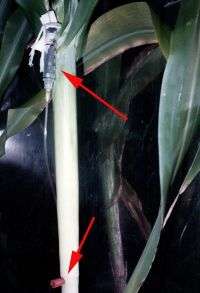To maximize biofuel potential, researchers look for sorghum's 'sweet spot'

Picture this - IV (intravenous) lines in a sorghum field. It's not as far-fetched as it sounds. It's one way that scientists at the Texas Agricultural Experiment Station are researching crops that may contribute to the biofuel revolution.
In Beaumont, Dr. Lee Tarpley, plant physiologist, and College Station colleague, Dr. Don Vietor, professor of crop physiology, have focused their research on sweet sorghum.
While sweet sorghum and sugarcane are close relatives, the researchers have shown that the two species have different ways of moving and storing sugar. Tracer sucrose is inserted into growing plants, using a system similar to an IV. Once the sucrose is inside the plants, the researchers can track the movement and distribution.
They found that, due to the plant's physiology, sweet sorghum appears to be more efficient in reusing the stored sugar to support growth of other parts of the plant. The mechanisms in sugarcane, however, allow it to accumulate very high levels of sucrose.
"The differences are critical, and need to be understood for breeders to develop new varieties specifically for the biofuel industry," Tarpley said. Sweet sorghum and sugarcane are both well suited for this purpose.
"While sorghum is an annual and can fit well into a crop rotation, sugarcane is a suitable perennial for many areas," Tarpley said. But to maximize the potential of sweet sorghum as a biofuel crop, breeders need to understand the physiology of the plant and not use sugarcane as a model.
"There is a large body of research on sugarcane that was previously thought to apply equally well to sorghum. Instead, we need to fully understand how sorghum moves and stores sugar in order to elevate to the next level in our breeding efforts," Tarpley said.
The study results were published in the June 2007 issue of BMC Plant Biology (www.biomedcentral.com/1471-2229/7/33).
Source: Texas A&M University















